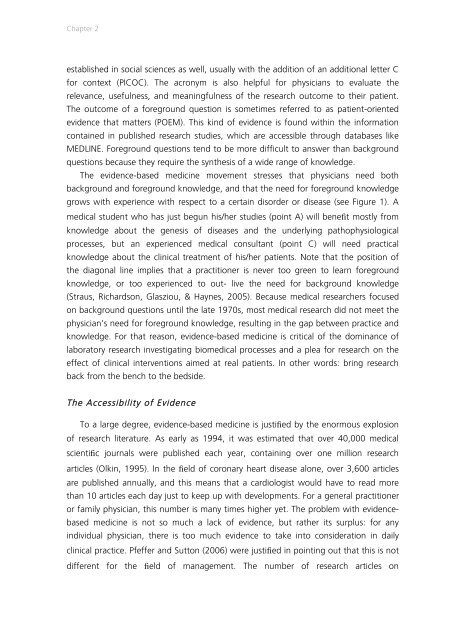In Search of Evidence
jqluvth
jqluvth
Create successful ePaper yourself
Turn your PDF publications into a flip-book with our unique Google optimized e-Paper software.
Chapter 2<br />
established in social sciences as well, usually with the addition <strong>of</strong> an additional letter C<br />
for context (PICOC). The acronym is also helpful for physicians to evaluate the<br />
relevance, usefulness, and meaningfulness <strong>of</strong> the research outcome to their patient.<br />
The outcome <strong>of</strong> a foreground question is sometimes referred to as patient-oriented<br />
evidence that matters (POEM). This kind <strong>of</strong> evidence is found within the information<br />
contained in published research studies, which are accessible through databases like<br />
MEDLINE. Foreground questions tend to be more difficult to answer than background<br />
questions because they require the synthesis <strong>of</strong> a wide range <strong>of</strong> knowledge.<br />
The evidence-based medicine movement stresses that physicians need both<br />
background and foreground knowledge, and that the need for foreground knowledge<br />
grows with experience with respect to a certain disorder or disease (see Figure 1). A<br />
medical student who has just begun his/her studies (point A) will benefit mostly from<br />
knowledge about the genesis <strong>of</strong> diseases and the underlying pathophysiological<br />
processes, but an experienced medical consultant (point C) will need practical<br />
knowledge about the clinical treatment <strong>of</strong> his/her patients. Note that the position <strong>of</strong><br />
the diagonal line implies that a practitioner is never too green to learn foreground<br />
knowledge, or too experienced to out- live the need for background knowledge<br />
(Straus, Richardson, Glasziou, & Haynes, 2005). Because medical researchers focused<br />
on background questions until the late 1970s, most medical research did not meet the<br />
physician’s need for foreground knowledge, resulting in the gap between practice and<br />
knowledge. For that reason, evidence-based medicine is critical <strong>of</strong> the dominance <strong>of</strong><br />
laboratory research investigating biomedical processes and a plea for research on the<br />
effect <strong>of</strong> clinical interventions aimed at real patients. <strong>In</strong> other words: bring research<br />
back from the bench to the bedside.<br />
The Accessibility <strong>of</strong> <strong>Evidence</strong><br />
To a large degree, evidence-based medicine is justified by the enormous explosion<br />
<strong>of</strong> research literature. As early as 1994, it was estimated that over 40,000 medical<br />
scientific journals were published each year, containing over one million research<br />
articles (Olkin, 1995). <strong>In</strong> the field <strong>of</strong> coronary heart disease alone, over 3,600 articles<br />
are published annually, and this means that a cardiologist would have to read more<br />
than 10 articles each day just to keep up with developments. For a general practitioner<br />
or family physician, this number is many times higher yet. The problem with evidencebased<br />
medicine is not so much a lack <strong>of</strong> evidence, but rather its surplus: for any<br />
individual physician, there is too much evidence to take into consideration in daily<br />
clinical practice. Pfeffer and Sutton (2006) were justified in pointing out that this is not<br />
different for the field <strong>of</strong> management. The number <strong>of</strong> research articles on


